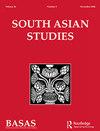Viewing Telugu Inscriptions at Ahobila
IF 0.7
0 ASIAN STUDIES
引用次数: 2
Abstract
One of the important pilgrimage centers (tīrtha) in South India, dedicated to the incarnation (avatāra) of Viṣṇu as Narasiṃha, the man-lion, is located at Ahobila, in the state of Andhra Pradesh. This site was important for the Vijayanagara kings as attested by numerous Telugu inscriptions dated to the 16th century. While their textual content provides valuable information on the social, political and economic cultures of sixteenth century South India, this paper investigates their meaning as visual signs within the contexts that comprise a pilgrimage site rather than as texts read by pilgrims. Additionally, given the paucity of scholarship on Telugu inscriptions, it also contributes to this understudied field.在阿霍比拉观看泰卢固语铭文
印度南部一个重要的朝圣中心(turtha),致力于Viṣṇu as Narasiṃha的化身(avatāra),人狮,位于安得拉邦的Ahobila。这个地方对维贾耶那加拉国王很重要,许多泰卢固人的铭文可以追溯到16世纪。虽然它们的文本内容提供了有关16世纪南印度社会、政治和经济文化的宝贵信息,但本文研究了它们作为视觉标志在包括朝圣地点的背景下的意义,而不是作为朝圣者阅读的文本。此外,由于泰卢固语铭文的学术研究不足,这也有助于这一研究不足的领域。
本文章由计算机程序翻译,如有差异,请以英文原文为准。
求助全文
约1分钟内获得全文
求助全文

 求助内容:
求助内容: 应助结果提醒方式:
应助结果提醒方式:


